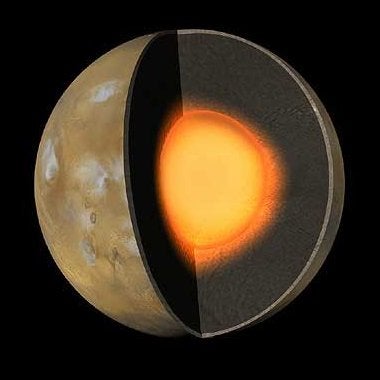Mars may be the god of war, but its namesake planet apparently has a soft heart. Information from the orbiting Mars Global Surveyor spacecraft suggests the martian core is at least partially fluid.
In a paper published online by Science on March 7, a team of scientists from the Jet Propulsion Laboratory (JPL) and California Institute of Technology report on their analysis of more than three years of orbital data from Mars Global Surveyor.
“Mars is influenced by the gravitational pull of the sun,” explains lead author and JPL planetary scientist Charles Yoder. “This causes a solid body tide with a bulge toward and away from the sun.” This is similar to the ocean tides our moon causes on Earth. However, the tidal changes on Mars measure less than a centimeter — tiny compared to Earth’s tides.
“The tidal bulge is a very small but detectable force on the spacecraft,” says JPL co-author Alex Konopliv. “It causes a drift in the tilt of the spacecraft’s orbit around Mars of one-thousandth of a degree over a month.”
“By measuring this bulge in the Mars gravity field we can determine how flexible Mars is,” Yoder adds. “The size of the measured tide is large enough to indicate the core of Mars can not be solid iron but must be at least partially liquid.”
The martian core may be entirely molten, or it may be like Earth’s — solid on the inside with a liquid outer core.
Yoder and his colleagues partnered the orbital data from Global Surveyor with earlier data about Mars’s precession from the Mars Pathfinder and Viking landers to learn more about the Red Planet’s core. (For instance, a faster precession rate is indicative of a larger dense core.) From this, the team determined that the size of the core is about half that of the planet’s size — like the cores of Venus and Earth. Additionally, this size suggests the martian core isn’t completely iron but contains a significant amount of a lighter element such as sulfur or hydrogen, the team reports.










